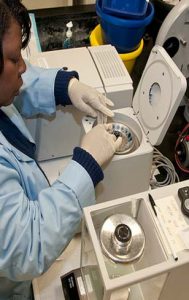
Why Is My Dog Or Cat’s Blood Amylase Level High?
Ron Hines DVM PhD
 See What Normal Blood & Urine Values Are
See What Normal Blood & Urine Values Are
 Causes Of Most Abnormal Blood & Urine Tests
Causes Of Most Abnormal Blood & Urine Tests
The Amylase Level In Your Dog Or Cat’s Blood
Amylase is an enzyme produced by your dog or cat’s pancreas to help digest the carbohydrates in food. Small amounts of amylase are also produced in your pet’s intestines and liver; but most amylase that finds its way into your pet’s blood stream originates from its pancreas. The great majority of amylase enzyme normally passes into your pet’s intestine through the two pancreatic ducts in dogs or the common bile duct in cats.
Problems That Can Cause Too Much Amylase To Be Present In Your Pet’s Blood:
Elevated blood amylase levels are of little significance in cats. Since cats are obligate carnivores, amylase plays a reduced role in their digestion. (read here) In dogs the test is a bit more reliable indicator of acute pancreatitis. Your pet’s blood amylase level can also be increased in pancreatic cancer or sudden severe trauma such as a car accident. It can also be moderately increased when chronic kidney disease is present – particularly in cats.
Lipemic (fatty) blood samples (a recent meal?) or hemolyzed samples (= red blood cells damaged during collection) can result in a falsely elevated amylase reading.
Medications that might increase amylase level in your pet include metronidazole (Flagyl®) and the diuretic, furosemide (Lasix®).
The amylase level in your pet’s bloodstream changes rapidly (hour by hour). That is because the compound has as very short lifespan. Because the blood amylase level can fluctuate so widely, the significance of the value your veterinarian obtains in a single test can be quite hard for him/her to interpret. Values less than twice the reported normals in dogs or cats may not be important (not significant for pancreatitis). When pancreatitis is suspected in a dog or a cat – such as one with a tender or bloated abdomen, an abdominal fluid tap (withdrawal) from its tummy is more likely to have a higher amylase reading than the reading obtained from the blood of the same pet.
Health Problems That Can Cause Too Little Amylase to be present in Your Pet’s Blood:
I know of none.
However, corticosteroid medications given when your dog or cat arrives in critical condition at an emergency clinic or pet hospital, has been known to lower amylase readings.
Complementary tests:
A CBC and a complete blood chemistry panel, Repeated amylase tests or better yet, tests that focus specifically on your pet’s pancreas – the cPL test for dogs or the fPL test for cats. Your pet’s blood lipase level, the pancreatic lipase immunoreactivity (TLI) test. Your pet’s blood glucose level, blood calcium, phosphorus & cholesterol, BUN, creatinine, ALT, AP, all of which are included in the general blood chemistry request. A urinalysis is always a good idea as well when the nature of a health issue remains uncertain.
DxMe
You are on the Vetspace animal health website
Visiting the products that you see displayed on this website help pay the cost of keeping these articles on the Internet.

